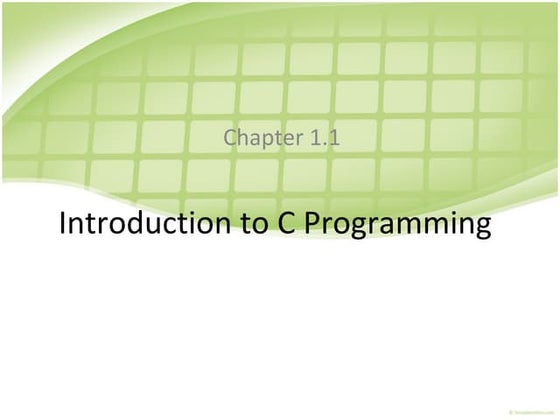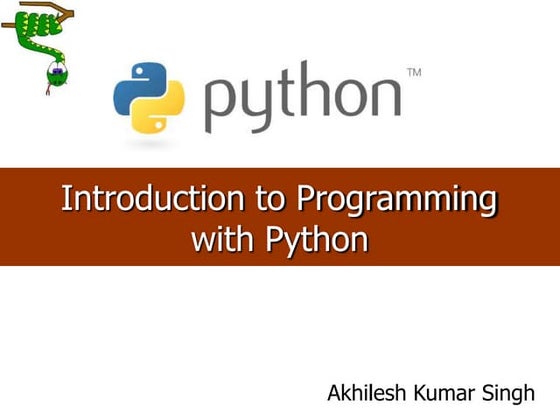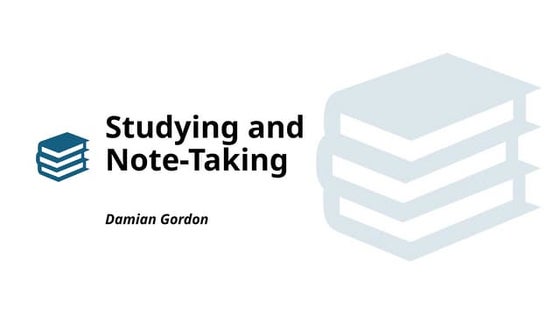chap2_Variables_In_Proraming_Introduction.ppt
- 1. Variables, Types, Assignments, Input, and Output EECS 280 Chuck Severance / Jim Eng
- 2. Variables ŌĆó A variable is a location where some value is stored - ŌĆ£the upper left drawerŌĆØ ŌĆó A value might be the current checkbook balance ŌĆó A variable has a name - ŌĆ£Which drawer?ŌĆØ ŌĆó A variable has a ŌĆ£typeŌĆØ - What can be stored in the drawer? X Y
- 3. Rules for Variable Names ŌĆó Variable names start with a letter or an underscore and consist of numbers, letters, or underscores ŌĆó Good names: x1 i abc123 ŌĆó Bad names: x+1 52pickup t&e ŌĆó C++ is case sensitive ŌĆō X1 and x1 are different variables ŌĆó Variable names can be any length
- 4. Variable Types ŌĆó Each variable in C++ must have a type ŌĆó The type determines what can be legally stored in a variable ŌĆó The type determines how much storage a variable occupies ŌĆó C++ has some built-in types ŌĆó Later we will define our own new types and then declare variables our types X J 1123 3.1415
- 5. Some Built-In Types C++ Type Examples Legal Values short 1, -43, 1024 -/+ 32,767 int 1, -43, 1024 -/+ 2,147,483,647 long 1, -43, 1024 -/+ 2,147,483,647 char ŌĆśaŌĆÖ ŌĆśbŌĆÖ ŌĆś0ŌĆÖ All single character values float 0.001 3.14 -10.2 10-38 to 1038 Seven digits of accuracy double 1.56 -0.1 46.3 10-308 to 10308 Fifteen digits of accuracy Note: On some systems the int type has a range of +/- 32,767
- 6. Declaring Variables ŌĆó At the beginning of a block of code, we declare variables for that block of code. ŌĆó We give each variable a type and a name main() { int i; float bankbal; char initial; }
- 7. Assignment Statements ŌĆó Set a variable to a value ŌĆó A variable can only hold one value ŌĆó The next assignment replaces the variable contents X 3.1415 X = 3.1415 100.0 X = 100.0 3.1415 X
- 8. This is not Algebra ŌĆó In Algebra ŌĆ£x=5ŌĆØ means ŌĆ£For the purposes of this problem, x is 5ŌĆØ ŌĆó In programming, ŌĆ£x=5ŌĆØ means: X=5 ŌĆ£Go find the memory location called x, blast whatever is in it, and set it to 5. And I mean NOW!ŌĆØ 178829 X 5
- 9. Still More main () { int ed,mary; ed = 17; mary = 2 * ( 14 + ed ); ed = ed + 3; } ŌĆó The right-hand side can be an expression instead of a constant ŌĆó The expression is computed BEFORE the assignment occurs ed mary
- 10. In the Beginning... ŌĆó What values are in variables right at the beginning of the program? main () { int ed,mary; ed = mary; } ?????? ed
- 11. In the Beginning... ŌĆó What values are in variables right at the beginning of the program? ŌĆó Garbage, bad stuff, smelly leftovers ŌĆó Behavior is officially ŌĆ£undefinedŌĆØ ŌĆó DonŌĆÖt assume zero main () { int ed,mary; ed = mary; } ?????? ed
- 12. Defining the Undefined ŌĆó There is a simple solution - we specify the initial value as part of the declaration of the variable. ŌĆó The syntax looks like an assignment ŌĆó Ed does not ŌĆ£stayŌĆØ zero ŌĆó Ed just starts out containing the value zero* main () { int ed = 0; int mary=17; ed = mary; } *Apologies to anyone named ŌĆ£EdŌĆØ - it is just an example
- 13. A Program main () { float celsius; float faren; celsius = 33.2; faren = ( (celsius * 9 ) / 5) + 32.0; } celsius faren
- 14. Language Assignment Syntax APL X 20 Pascal X := 20 COBOL MOVE 20 TO X BASIC LET X = 20 FORTRAN X = 20 C and C++ X = 20 The History of Assignment ŌĆó There is disagreement among computer languages as to how to represent this act of moving data into a variable
- 15. Running A Program main () { float celsius; float faren; celsius = 33.2; faren = ( (celsius * 9 ) / 5) + 32.0; } Output: % g++ samp1.c % a.out % Run the G++ Compiler Run the compiled program
- 16. Expressions ŌĆó Any place a value can be used, an expression can also be used - the value is computed from the expression celsius = 33.2; faren = ( (celsius * 9 ) / 5) + 32.0;
- 17. Operators C/C++ Operator Operation + - Addition Subtraction * / Multiplication Division % Remainder (Integer division) Expression Value Notes 3 + 4 7 5 - 1 + 2 6 5 - 1 is done first (left to right) 5 * 2 + 4 14 All multiplication and division is done before add and subtract 5 * ( 2 + 4 ) 30 Parenthesis rule! 32 % 6 2 The remainder of 32/6 is 2
- 18. Expression Gymnastics celsius = 100; faren = ( (celsius * 9 ) / 5) + 32.0; 900.0 100.0 180.0 900.0
- 19. Mixing Types ŌĆó When expressions mix types, C++ converts data according to rules char -> int -> long -> float -> double ŌĆó These rules apply as each sub-expression is evaluated ŌĆó For an assignment, the type of the right- hand-side is converted at the last minute just before the value is assigned.
- 20. Type Gymnastics celsius = 100; faren = ( (celsius * 9 ) / 5) + 32.0; 900.0 100.0 180.0 900.0
- 21. Input and Output ŌĆó Programs must interact with something ŌĆō Keyboard, screen, joystick, speaker, temperature sensor, keypad (like on a cell phone) ŌĆó When a program takes data from something we call it ŌĆ£inputŌĆØ ŌĆó When a program sends its data to something, we call it ŌĆ£outputŌĆØ
- 22. Streams ŌĆó When we start programming, we keep things simple - we read from the keyboard and write to a text screen ŌĆó In C++ this is done using ŌĆ£streamsŌĆØ ŌĆō cin - The input stream ŌĆō cout - The output stream
- 23. Ouput Stream ŌĆó To display information on the screen we use the insertion operator with cout #include <iostream.h> main () { float celsius; float faren; celsius = 33.2; faren = ( (celsius * 9 ) / 5) + 32.0; cout << faren; } Output: % g++ samp2.c % a.out 91.76%
- 24. Your Responsibility Computers are getting so fast and so capable that it will not be long until computers will do what you want them to do instead of what you tell them to do. Gerard P. Weeg (paraphrased ca. 1963)
- 25. Output Streams ŌĆó When using cout, we need to manage the end of lines and white space ŌĆó End of line ŌĆó White space cout << endl; or cout << ŌĆ£nŌĆØ; cout << ŌĆ£ ŌĆ£; NewLine character
- 26. #include <iostream.h> main () { float celsius; float faren; celsius = 33.2; faren = ( (celsius * 9 ) / 5) + 32.0; cout << faren; } Output: % g++ samp2.c % a.out 91.76% #include <iostream.h> main () { float celsius; float faren; celsius = 33.2; faren = ( (celsius * 9 ) / 5) + 32.0; cout << faren; cout << endl; // Add A NewLine } Output: % g++ samp3.c % a.out 91.76 % We Said We Got We Wanted We Needed to Say
- 27. More cout ŌĆó You can ŌĆ£sendŌĆØ multiple things to cout with multiple ŌĆ£<<ŌĆ£ operators ŌĆó Most people think of the ŌĆ£<<ŌĆ£ operator as ŌĆ£send toŌĆØ means ŌĆ£send the value contained in the variable faren to the screenŌĆØ cout << ŌĆ£Farenheight ŌĆ£ << faren << endl; cout << faren;
- 28. Input ŌĆó The most basic form of input is from the keyboard. For this we use the ŌĆ£cinŌĆØ input stream and the ŌĆ£>>ŌĆØ extraction operator. ŌĆó Based on the type of the variable (celsius), a value is read from the keyboard and stored in the variable cin >> celsius;
- 29. A ŌĆ£RealŌĆØ Program #include <iostream.h> main () { float celsius; float faren; cout << ŌĆ£Enter a Celsius Value ŌĆØ; cin >> celsius; faren = ( (celsius * 9 ) / 5) + 32.0; cout << ŌĆ£Converted value ŌĆ£; cout << faren << endl; } Output: % g++ samp4.c % a.out Enter a Celsius Value 100 Converted value 212 % Note Spaces
- 30. The History of Input/Output FORTRAN: READ *,X PRINT *,X BASIC: READ X PRINT X C: scanf(ŌĆ£%fŌĆØ,&x); printf(ŌĆ£%fŌĆØ,x); C++: cin >> x; cout << x; FORTRAN (Formatted): READ 100,X 100 FORMAT(F8.2) PRINT 200,X 200 FORMAT(1X,F8.2)
- 31. A Pattern in Programs Processing (Calculations) Input Output y = x + 1; cin >> x; cout << y;
- 32. Prompting for Input ŌĆó Another common pattern for interactive programs is to issue a ŌĆ£promptŌĆØ before reading input so the user knows what to type. ŌĆ”. cout << ŌĆ£Enter a Celsius Value ŌĆØ; cin >> celsius; faren = ( (celsius * 9 ) / 5) + 32.0; ŌĆ”. Enter a Celsius Value 100 Converted value 212
Editor's Notes
- #8: Algebra is about stating what is true, computer programming is about giving orders. Think about barking out orders orders to move stuff around.
- #17: When in doubt - use parenthesis.
- #21: If a Celsius value is converted to Farenheight and no one sees it, was it ever really converted?
- #24: Gerard was wrong and is still wrong.
- #28: In some ways, this is like an assignment statement - the value in the vartiable is overwritten.

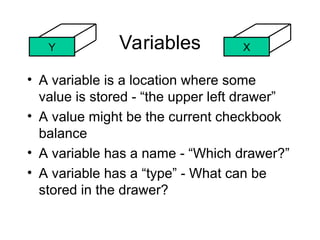

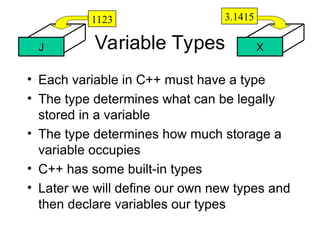

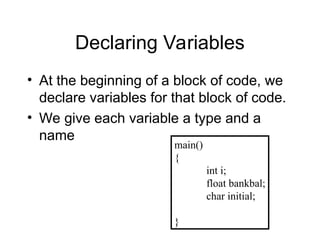















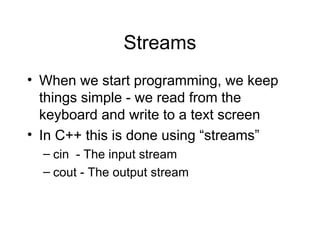




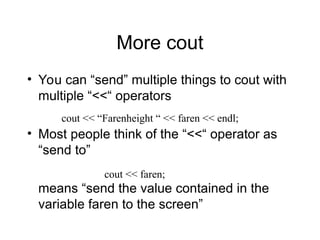
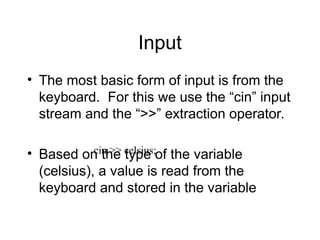
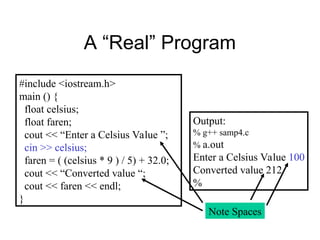
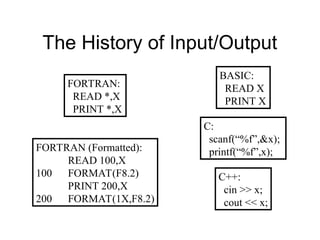
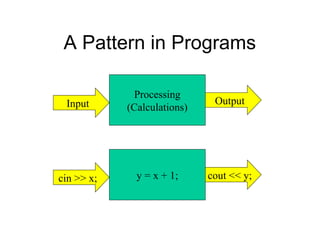
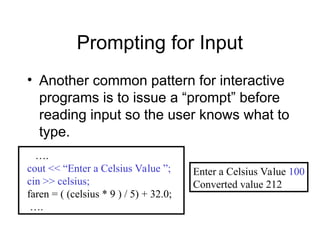






![Oh Crap, I Forgot (Or Never Learned) C! [CodeMash 2010]](https://cdn.slidesharecdn.com/ss_thumbnails/oh-crap-i-never-learned-c-codemash-2010-100115163750-phpapp01-thumbnail.jpg?width=560&fit=bounds)









